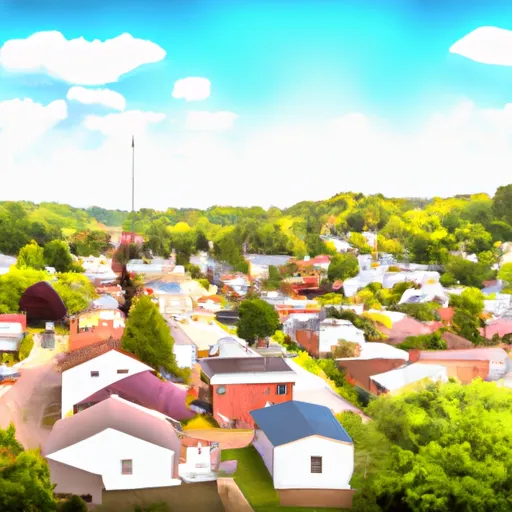-
 Snoflo Premium
Snoflo Premium
Get unlimited access to all our content
With no Ad interruptions! - Start Your Free Trial Login with existing account
Kyrock
Eden Index
Climate
7.8
•
Recreation
6.3
•
Community
0.7
•
Safeguard
5.5/10

Kyrock, Kentucky is a small community located in Edmonson County. The climate in Kyrock is considered humid subtropical, characterized by hot summers and mild winters. Summers are typically hot and humid, with temperatures ranging from the mid-80s to low 90s Fahrenheit. Winters are usually mild, with temperatures ranging from the 30s to 50s Fahrenheit. Precipitation is evenly distributed throughout the year, with slightly higher rainfall in spring and summer.
Hydrologically, Kyrock is known for its proximity to Nolin River, a major waterbody in the region. The river is a popular spot for fishing, canoeing, and kayaking. It is home to a diverse range of fish species, including bass, crappie, and catfish. The area surrounding Kyrock also features numerous creeks and waterfalls, providing opportunities for swimming and hiking.
Outdoor recreation enthusiasts will find ample opportunities in Kyrock. The nearby Mammoth Cave National Park offers a variety of activities, including cave tours, hiking trails, and camping. The park is known for its extensive cave system, making it a popular destination for caving enthusiasts. Additionally, the area is surrounded by rolling hills and forests, providing opportunities for hunting, birdwatching, and wildlife photography.
What is the Eden Index?
The Snoflo Eden Index serves as a comprehensive rating system for regions, evaluating their desirability through a holistic assessment of climate health, outdoor recreation opportunities, and natural disaster risk, acknowledging the profound impact of these factors on livability and well-being.
Climate Health Indicator (CHI): 7.8
Kyrock receives approximately
1322mm of rain per year,
with humidity levels near 83%
and air temperatures averaging around
14°C.
Kyrock has a plant hardyness factor of
6, meaning
plants and agriculture in this region thrive during a short period during spring and early summer. Most
plants will die off during the colder winter months.
By considering the ideal temperature range, reliable water supplies, clean air, and stable seasonal rain or snowpacks, the Climate Health Indicator (CHI) underscores the significance of a healthy climate as the foundation for quality living.
A healthy climate is paramount for ensuring a high quality of life and livability in a region, fostering both physical well-being and environmental harmony. This can be characterized by ideal temperatures, reliable access to water supplies, clean air, and consistent seasonal rain or snowpacks.
Weather Forecast
Streamflow Conditions
Green
Area Rivers
Green
Snowpack Depths
Green
Reservoir Storage Capacity
Green
Groundwater Levels
Recreational Opportunity Index (ROI): 6.3
The Recreational Opportunity Index (ROI) recognizes the value of outdoor recreational options, such as parks, hiking trails, camping sites, and fishing spots, while acknowledging that climate plays a pivotal role in ensuring the comfort and consistency of these experiences.
Access to outdoor recreational opportunities, encompassing activities such as parks, hiking, camping, and fishing, is crucial for overall well-being, and the climate plays a pivotal role in enabling and enhancing these experiences, ensuring that individuals can engage in nature-based activities comfortably and consistently.
Camping Areas
| Campground | Campsites | Reservations | Toilets | Showers | Elevation |
|---|---|---|---|---|---|
| Goose Pond Colony | None | 618 ft | |||
| Sharon Johnston Park | 33 | 771 ft | |||
| Barton Springs - Normandy Lake | 67 | 885 ft | |||
| Old Stone Fort State Park | 51 | 1,005 ft | |||
| Cathedral Caverns State Park | None | 643 ft | |||
| Arnold AFB Military | None | 1,001 ft | |||
| Cedar Point - Normandy Lake | None | 882 ft | |||
| Tims Ford State Park | 52 | 936 ft | |||
| Lake Guntersville State Park | 366 | 630 ft | |||
| Marshall County Park | None | 598 ft |
Nearby Ski Areas
Catastrophe Safeguard Index (CSI):
The Catastrophe Safeguard Index (CSI) recognizes that natural disaster risk, encompassing floods, fires, hurricanes, and tornadoes, can drastically affect safety and the overall appeal of an area.
The level of natural disaster risk in a region significantly affects safety and the overall livability, with climate change amplifying these risks by potentially increasing the frequency and intensity of events like floods, fires, hurricanes, and tornadoes, thereby posing substantial challenges to community resilience and well-being.
Community Resilience Indicator (CRI): 0.7
The Community Resilience Indicator (CRI) recognizes that education, healthcare, and socioeconomics are crucial to the well-being of a region. The CRI acknowledges the profound impact of these elements on residents' overall quality of life. By evaluating educational resources, healthcare accessibility, and economic inclusivity, the index captures the essential aspects that contribute to a thriving community, fostering resident satisfaction, equity, and social cohesion.

